Abstract
AIM: To investigate the significance of urinary tissue factor (uTF) concentrations in patients with glomerulonephritis. METHODS: Urine samples were collected from normal subjects (n = 57), patients with uncomplicated renal stones (n = 30), and patients with glomerulonephritis (n = 150). Samples were then centrifuged and the pellets solubilised in n-octyl-beta-glucopyranoside. uTF concentrations were determined using a one stage kinetic chromogenic assay. RESULTS: The uTF concentration was higher in patients with glomerulonephritis than in normal controls (p < 0.01) or in patients with renal stones (p < 0.05). uTF activity correlated with the protein creatinine index (PCI, r = 0.41, p < 0.001) and seven patients with glomerulonephritis and a PCI < or = 0.1 g/mmol had raised uTF. Glomerulonephritis patients were subdivided into two groups depending on the PCI: < 0.2 g/mmol creatinine (mild to moderate proteinuria, group I) and > or = 0.2 g/mmol creatinine (heavy proteinuria, group II). In group I, uTF concentrations were higher in patients with either immune complex (IC) glomerulonephritis (p < 0.01) or non-IC (p < 0.05) glomerulonephritis than in normal controls. In group II, the IC glomerulonephritis group had higher uTF concentrations than normal controls (p < 0.001) or patients with renal stones (p < 0.01); and non-IC glomerulonephritis patients had higher uTF than normal controls (p < 0.01). When the glomerulonephritis groups were divided into broad WHO subtypes, the significance level varied with the type of glomerulonephritis. CONCLUSIONS: uTF is increased in patients with glomerulonephritis, and its concentration may reflect the aetiopathogenesis of glomerulonephritis.
Full text
PDF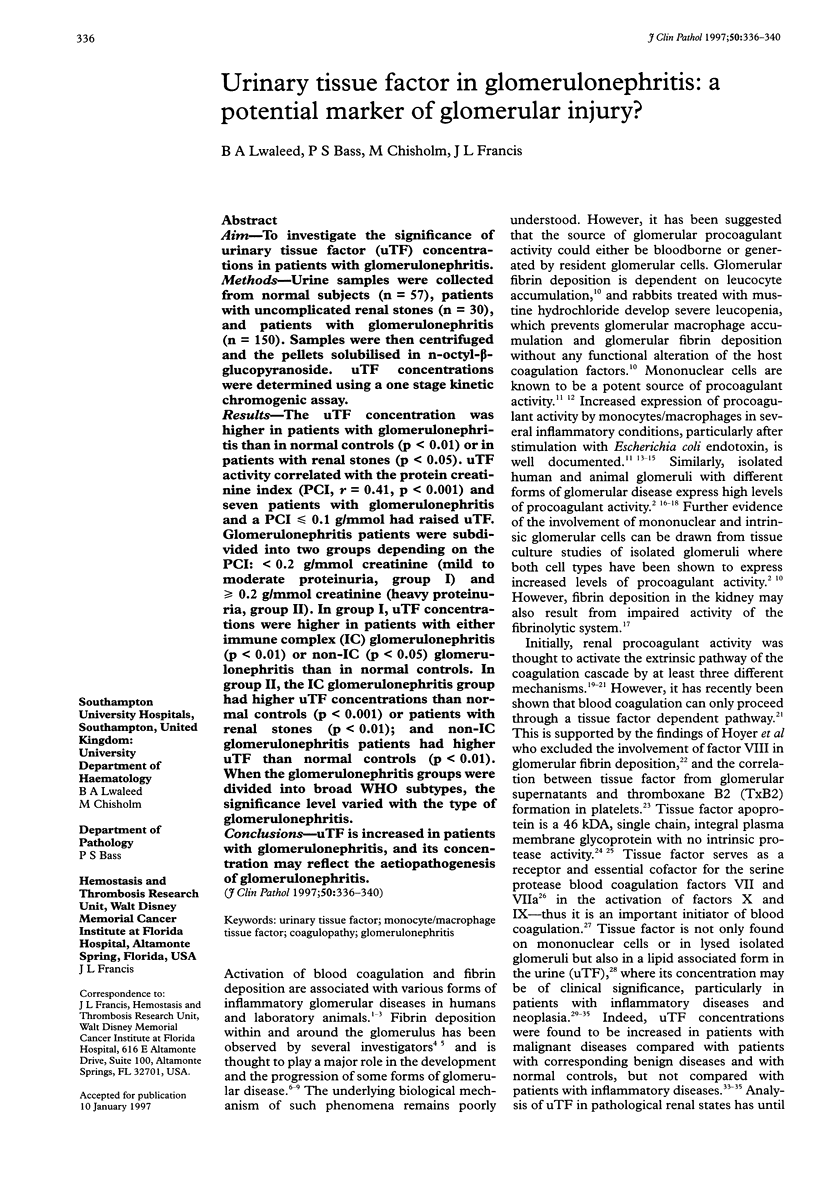
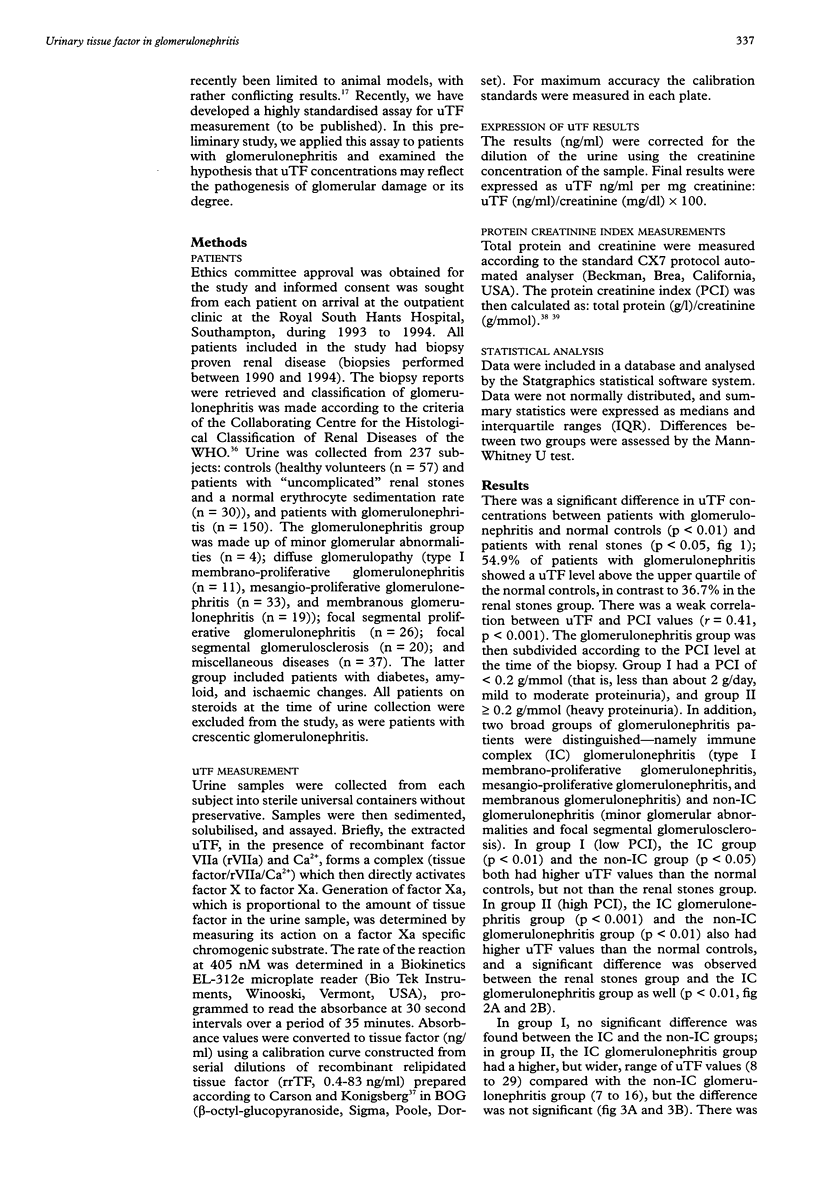
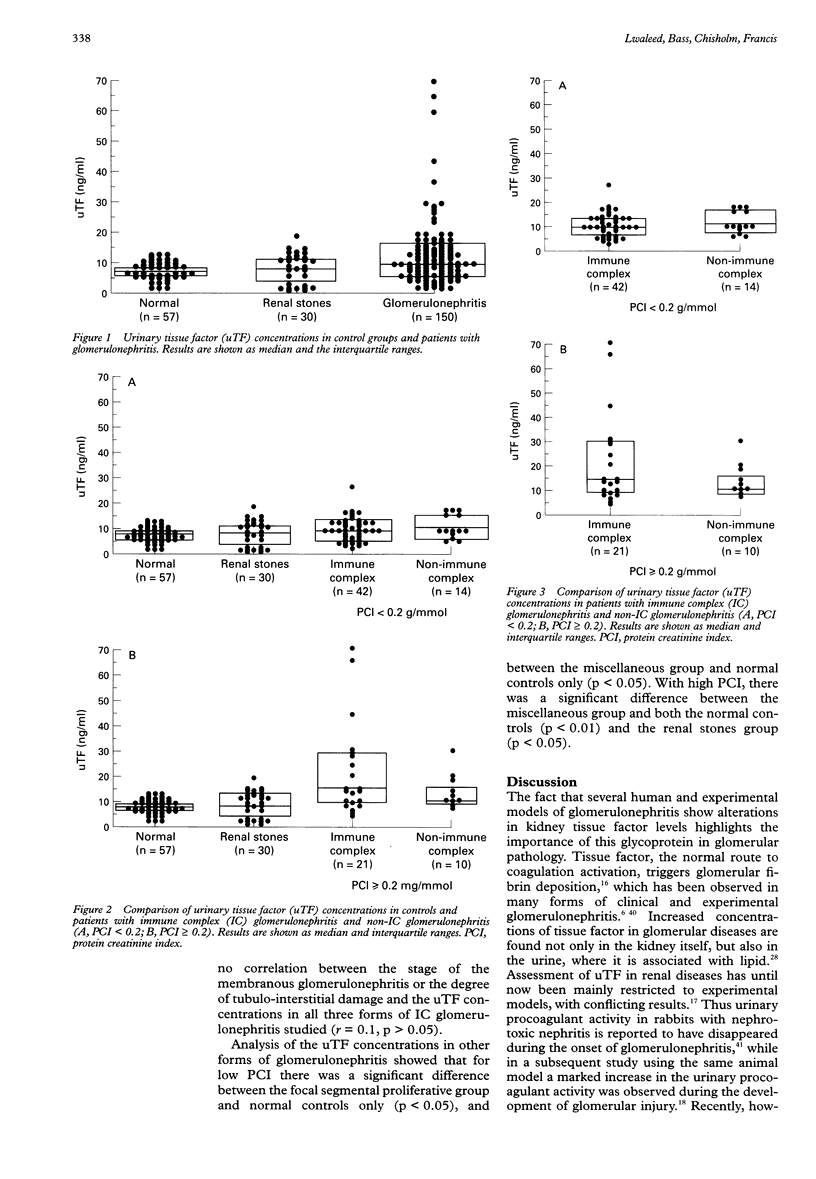
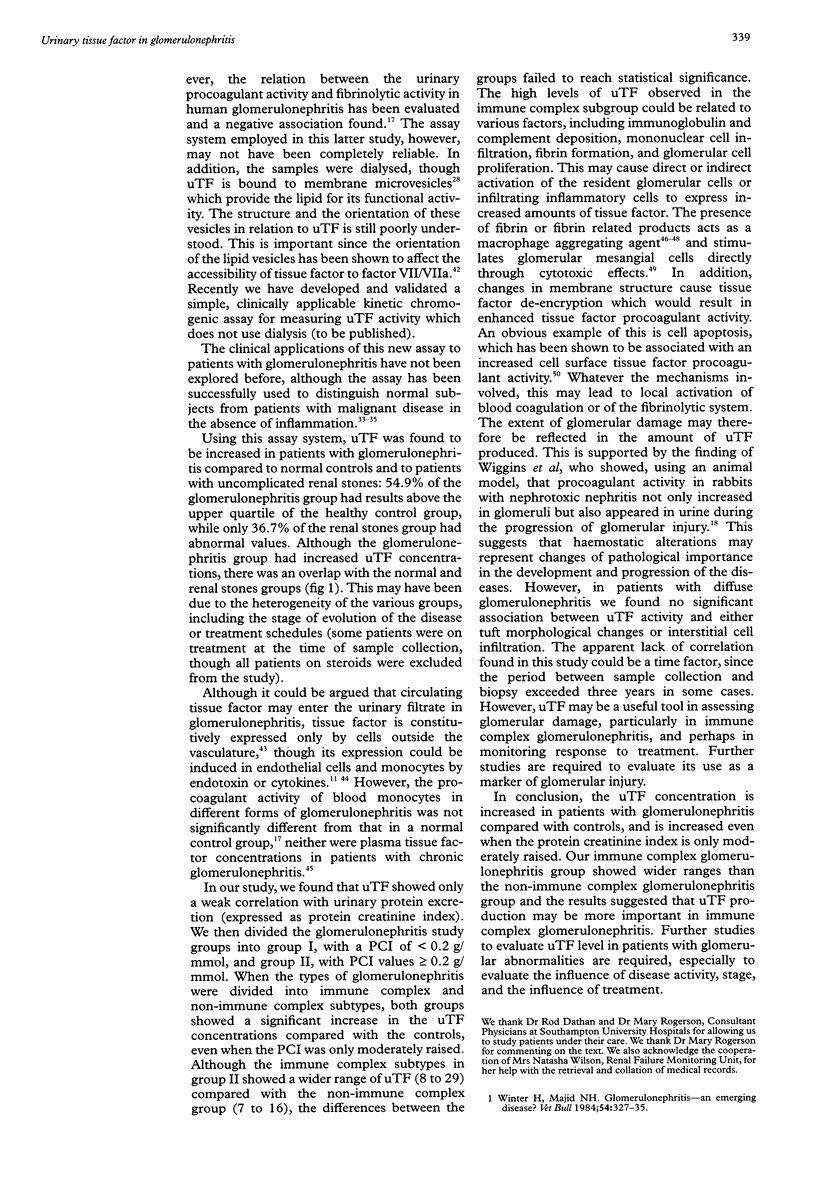
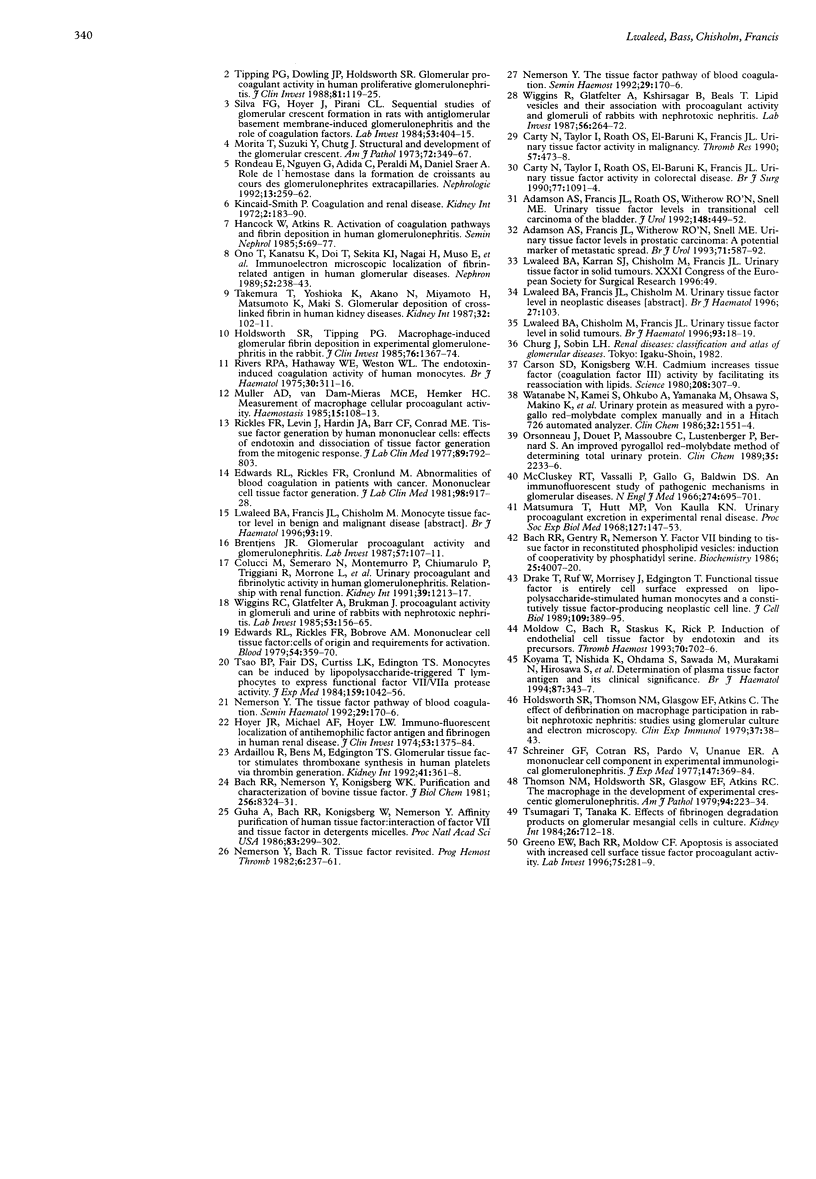
Selected References
These references are in PubMed. This may not be the complete list of references from this article.
- Adamson A. S., Francis J. L., Roath O. S., Witherow R. O., Snell M. E. Urinary tissue factor levels in transitional cell carcinoma of the bladder. J Urol. 1992 Aug;148(2 Pt 1):449–452. doi: 10.1016/s0022-5347(17)36626-0. [DOI] [PubMed] [Google Scholar]
- Adamson A. S., Francis J. L., Witherow R. O., Snell M. E. Urinary tissue factor levels in prostatic carcinoma: a potential marker of metastatic spread? Br J Urol. 1993 May;71(5):587–592. doi: 10.1111/j.1464-410x.1993.tb16030.x. [DOI] [PubMed] [Google Scholar]
- Ardaillou R., Bens M., Edgington T. S. Glomerular tissue factor stimulates thromboxane synthesis in human platelets via thrombin generation. Kidney Int. 1992 Feb;41(2):361–368. doi: 10.1038/ki.1992.50. [DOI] [PubMed] [Google Scholar]
- Bach R., Gentry R., Nemerson Y. Factor VII binding to tissue factor in reconstituted phospholipid vesicles: induction of cooperativity by phosphatidylserine. Biochemistry. 1986 Jul 15;25(14):4007–4020. doi: 10.1021/bi00362a005. [DOI] [PubMed] [Google Scholar]
- Brentjens J. R. Glomerular procoagulant activity and glomerulonephritis. Lab Invest. 1987 Aug;57(2):107–111. [PubMed] [Google Scholar]
- Carson S. D., Konigsberg W. H. Cadmium increases tissue factor (coagulation factor III) activity by facilitating its reassociation with lipids. Science. 1980 Apr 18;208(4441):307–309. doi: 10.1126/science.7367861. [DOI] [PubMed] [Google Scholar]
- Carty N., Taylor I., Roath O. S., el-Baruni K., Francis J. L. Urinary tissue factor activity in colorectal disease. Br J Surg. 1990 Oct;77(10):1091–1094. doi: 10.1002/bjs.1800771005. [DOI] [PubMed] [Google Scholar]
- Carty N., Taylor I., Roath O. S., el-Baruni K., Francis J. L. Urinary tissue factor activity in malignancy. Thromb Res. 1990 Feb 1;57(3):473–478. doi: 10.1016/0049-3848(90)90263-c. [DOI] [PubMed] [Google Scholar]
- Colucci M., Semeraro N., Montemurro P., Chiumarulo P., Triggiani R., Morrone L. F., Schena F. P. Urinary procoagulant and fibrinolytic activity in human glomerulonephritis. Relationship with renal function. Kidney Int. 1991 Jun;39(6):1213–1217. doi: 10.1038/ki.1991.153. [DOI] [PubMed] [Google Scholar]
- Drake T. A., Ruf W., Morrissey J. H., Edgington T. S. Functional tissue factor is entirely cell surface expressed on lipopolysaccharide-stimulated human blood monocytes and a constitutively tissue factor-producing neoplastic cell line. J Cell Biol. 1989 Jul;109(1):389–395. doi: 10.1083/jcb.109.1.389. [DOI] [PMC free article] [PubMed] [Google Scholar]
- Edwards R. L., Rickles F. R., Bobrove A. M. Mononuclear cell tissue factor: cell of origin and requirements for activation. Blood. 1979 Aug;54(2):359–370. [PubMed] [Google Scholar]
- Edwards R. L., Rickles F. R., Cronlund M. Abnormalities of blood coagulation in patients with cancer. Mononuclear cell tissue factor generation. J Lab Clin Med. 1981 Dec;98(6):917–928. [PubMed] [Google Scholar]
- Greeno E. W., Bach R. R., Moldow C. F. Apoptosis is associated with increased cell surface tissue factor procoagulant activity. Lab Invest. 1996 Aug;75(2):281–289. [PubMed] [Google Scholar]
- Guha A., Bach R., Konigsberg W., Nemerson Y. Affinity purification of human tissue factor: interaction of factor VII and tissue factor in detergent micelles. Proc Natl Acad Sci U S A. 1986 Jan;83(2):299–302. doi: 10.1073/pnas.83.2.299. [DOI] [PMC free article] [PubMed] [Google Scholar]
- Hancock W., Atkins R. Activation of coagulation pathways and fibrin deposition in human glomerulonephritis. Semin Nephrol. 1985 Mar;5(1):69–77. [PubMed] [Google Scholar]
- Holdsworth S. R., Thomson N. M., Glasgow E. F., Atkins R. C. The effect of defibrination on macrophage participation in rabbit nephrotoxic nephritis: studies using glomerular culture and electronmicroscopy. Clin Exp Immunol. 1979 Jul;37(1):38–43. [PMC free article] [PubMed] [Google Scholar]
- Holdsworth S. R., Tipping P. G. Macrophage-induced glomerular fibrin deposition in experimental glomerulonephritis in the rabbit. J Clin Invest. 1985 Oct;76(4):1367–1374. doi: 10.1172/JCI112112. [DOI] [PMC free article] [PubMed] [Google Scholar]
- Hoyer J. R., Michael A. F., Hoyer L. W. Immunofluorescent localization of antihemophilic factor antigen and fibrinogen in human renal diseases. J Clin Invest. 1974 May;53(5):1375–1384. doi: 10.1172/JCI107686. [DOI] [PMC free article] [PubMed] [Google Scholar]
- Kincaid-Smith P. Coagulation and renal disease. Kidney Int. 1972 Oct;2(4):183–190. doi: 10.1038/ki.1972.93. [DOI] [PubMed] [Google Scholar]
- Koyama T., Nishida K., Ohdama S., Sawada M., Murakami N., Hirosawa S., Kuriyama R., Matsuzawa K., Hasegawa R., Aoki N. Determination of plasma tissue factor antigen and its clinical significance. Br J Haematol. 1994 Jun;87(2):343–347. doi: 10.1111/j.1365-2141.1994.tb04919.x. [DOI] [PubMed] [Google Scholar]
- Matsumura T., Hutt M. P., Von Kaulla K. N. Urinary procoagulant excretion in experimental renal disease. Proc Soc Exp Biol Med. 1968 Jan;127(1):147–153. doi: 10.3181/00379727-127-32643. [DOI] [PubMed] [Google Scholar]
- McCluskey R. T., Vassalli P., Gallo G., Baldwin D. S. An immunofluorescent study of pathogenic mechanisms in glomerular diseases. N Engl J Med. 1966 Mar 31;274(13):695–701. doi: 10.1056/NEJM196603312741301. [DOI] [PubMed] [Google Scholar]
- Moldow C. F., Bach R. R., Staskus K., Rick P. D. Induction of endothelial tissue factor by endotoxin and its precursors. Thromb Haemost. 1993 Oct 18;70(4):702–706. [PubMed] [Google Scholar]
- Morita T., Suzuki Y., Churg J. Structure and development of the glomerular crescent. Am J Pathol. 1973 Sep;72(3):349–368. [PMC free article] [PubMed] [Google Scholar]
- Muller A. D., van Dam-Mieras M. C., Hemker H. C. Measurement of macrophage cellular procoagulant activity. Haemostasis. 1985;15(2):108–113. doi: 10.1159/000215130. [DOI] [PubMed] [Google Scholar]
- Nemerson Y., Bach R. Tissue factor revisited. Prog Hemost Thromb. 1982;6:237–261. [PubMed] [Google Scholar]
- Nemerson Y. The tissue factor pathway of blood coagulation. Semin Hematol. 1992 Jul;29(3):170–176. [PubMed] [Google Scholar]
- Nemerson Y. The tissue factor pathway of blood coagulation. Semin Hematol. 1992 Jul;29(3):170–176. [PubMed] [Google Scholar]
- Ono T., Kanatsu K., Doi T., Sekita K., Nagai H., Muso E., Yoshida H., Tamura T., Kawai C. Immunoelectron microscopic localization of fibrin-related antigen in human glomerular diseases. Nephron. 1989;52(3):238–243. doi: 10.1159/000185649. [DOI] [PubMed] [Google Scholar]
- Orsonneau J. L., Douet P., Massoubre C., Lustenberger P., Bernard S. An improved pyrogallol red-molybdate method for determining total urinary protein. Clin Chem. 1989 Nov;35(11):2233–2236. [PubMed] [Google Scholar]
- Rickles F. R., Levin J., Hardin J. A., Barr C. F., Conrad M. E., Jr Tissue factor generation by human mononuclear cells: effects of endotoxin and dissociation of tissue factor generation from mitogenic response. J Lab Clin Med. 1977 Apr;89(4):792–803. [PubMed] [Google Scholar]
- Rivers R. P., Hathaway W. E., Weston W. L. The endotoxin-induced coagulant activity of human monocytes. Br J Haematol. 1975 Jul;30(3):311–316. doi: 10.1111/j.1365-2141.1975.tb00547.x. [DOI] [PubMed] [Google Scholar]
- Rondeau E., Nguyen G., Adida C., Peraldi M. N., Kanfer A., Sraer J. D. Rôle de l'hémostase dans la formation de croissants au cours des glomérulonéphrites extracapillaires. Nephrologie. 1992;13(6):259–262. [PubMed] [Google Scholar]
- Schreiner G. F., Cotran R. S., Pardo V., Unanue E. R. A mononuclear cell component in experimental immunological glomerulonephritis. J Exp Med. 1978 Feb 1;147(2):369–384. doi: 10.1084/jem.147.2.369. [DOI] [PMC free article] [PubMed] [Google Scholar]
- Silva F. G., Hoyer J. R., Pirani C. L. Sequential studies of glomerular crescent formation in rats with antiglomerular basement membrane-induced glomerulonephritis and the role of coagulation factors. Lab Invest. 1984 Oct;51(4):404–415. [PubMed] [Google Scholar]
- Takemura T., Yoshioka K., Akano N., Miyamoto H., Matsumoto K., Maki S. Glomerular deposition of cross-linked fibrin in human kidney diseases. Kidney Int. 1987 Jul;32(1):102–111. doi: 10.1038/ki.1987.178. [DOI] [PubMed] [Google Scholar]
- Thomson N. M., Holdsworth S. R., Glasgow E. F., Atkins R. C. The macrophage in the development of experimental crescentic glomerulonephritis. Studies using tissue culture and electron microscopy. Am J Pathol. 1979 Feb;94(2):223–240. [PMC free article] [PubMed] [Google Scholar]
- Tipping P. G., Dowling J. P., Holdsworth S. R. Glomerular procoagulant activity in human proliferative glomerulonephritis. J Clin Invest. 1988 Jan;81(1):119–125. doi: 10.1172/JCI113282. [DOI] [PMC free article] [PubMed] [Google Scholar]
- Tsao B. P., Fair D. S., Curtiss L. K., Edgington T. S. Monocytes can be induced by lipopolysaccharide-triggered T lymphocytes to express functional factor VII/VIIa protease activity. J Exp Med. 1984 Apr 1;159(4):1042–1057. doi: 10.1084/jem.159.4.1042. [DOI] [PMC free article] [PubMed] [Google Scholar]
- Tsumagari T., Tanaka K. Effects of fibrinogen degradation products on glomerular mesangial cells in culture. Kidney Int. 1984 Nov;26(5):712–718. doi: 10.1038/ki.1984.206. [DOI] [PubMed] [Google Scholar]
- Watanabe N., Kamei S., Ohkubo A., Yamanaka M., Ohsawa S., Makino K., Tokuda K. Urinary protein as measured with a pyrogallol red-molybdate complex, manually and in a Hitachi 726 automated analyzer. Clin Chem. 1986 Aug;32(8):1551–1554. [PubMed] [Google Scholar]
- Wiggins R. C., Glatfelter A., Brukman J. Procoagulant activity in glomeruli and urine of rabbits with nephrotoxic nephritis. Lab Invest. 1985 Aug;53(2):156–165. [PubMed] [Google Scholar]
- Wiggins R., Glatfelter A., Kshirsagar B., Beals T. Lipid microvesicles and their association with procoagulant activity in urine and glomeruli of rabbits with nephrotoxic nephritis. Lab Invest. 1987 Mar;56(3):264–272. [PubMed] [Google Scholar]


